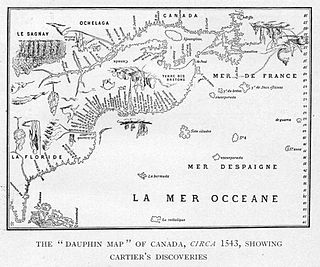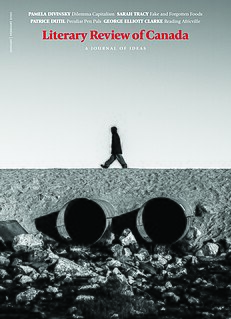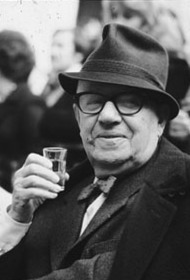Agouhanna was the St. Lawrence Iroquoian term for chief or leader.
Agouhanna was the St. Lawrence Iroquoian term for chief or leader.
This section possibly contains original research .(March 2021) |
The word has been mistakenly interpreted as being the name of the chief of Hochelaga, on the site of present-day Montreal. This confusion stems from a passage in Bref récit by Jacques Cartier (translated by Richard Hakluyt), in which French explorer Cartier first meets the chief of Hochelaga. The passage reads "...the Lord & King of the countrey was brought upon 9 or 10 mens shoulders (whom in their tongue they call Agouhanna)" [1] [ non-primary source needed ] This passage was interpreted as meaning that Agouhanna was the name of the Hochelagan chief. This proves not to be the case, as in Jacques Cartier's work entitled Bref Recit Et Succincte Narration de la Navigation Faite en MDXXXV et MDXXXVI par Le Capitaine Jacques Cartier Aux Iles de Canada, Hochelaga, Saguenay, et Autres, he recounts his meeting with Donnacona, chief of Stadacona, near present-day Quebec City, saying, "...le seigneur de Canada nomé Donnacona en nom, & l'appelent pour seigneur Agouhanna..." [2] [ non-primary source needed ] This translates as: "the chief of Canada, called Donnacona by name, and called 'Agouhanna' for 'chief'." This means, therefore, that the word Agouhanna means 'chief', and is not a proper name. Jacques Cartier only referred to the leader of Hochelaga as the 'chief', and not by his name, which was never recorded.

The St. Lawrence River is a large river in the middle latitudes of North America, flowing from Lake Ontario in a roughly northeasterly direction into the Gulf of St. Lawrence, connecting the Great Lakes to the North Atlantic Ocean and forming the primary drainage outflow of the Great Lakes Basin. The river traverses the Canadian provinces of Ontario and Quebec as well as the U.S. state of New York, and is part of the international boundary between Canada and the United States. It also provides the basis for the commercial St. Lawrence Seaway.

Jacques Cartier was a French-Breton maritime explorer for France. Jacques Cartier was the first European to describe and map the Gulf of Saint Lawrence and the shores of the Saint Lawrence River, which he named "The Country of Canadas" after the Iroquoian names for the two big settlements he saw at Stadacona and at Hochelaga.

Richard Hakluyt was an English writer. He is known for promoting the English colonisation of North America through his works, notably Divers Voyages Touching the Discoverie of America (1582) and The Principall Navigations, Voiages, Traffiques and Discoueries of the English Nation (1589–1600).
Portneuf County is a historic county in Quebec, Canada west of Quebec City on the Saint Lawrence River in Canada.

The colony of Canada was a French colony within the larger territory of New France. It was claimed by France in 1535 during the second voyage of Jacques Cartier, when the land was claimed in the name of the French king, Francis I. Canada remained a French territory until 1763, when it became a British colony known as the Province of Quebec.

Stadacona was a 16th-century St. Lawrence Iroquoian village not far from where Quebec City was founded in 1608.

While a variety of theories have been postulated for the name of Canada, its origin is now accepted as coming from the St. Lawrence Iroquoian word kanata, meaning "village" or "settlement". In 1535, Indigenous inhabitants of the present-day Quebec City region used the word to direct French explorer Jacques Cartier to the village of Stadacona. Cartier later used the word Canada to refer not only to that particular village but to the entire area subject to Donnacona ; by 1545, European books and maps had begun referring to this small region along the Saint Lawrence River as Canada.

Chief Donnacona was the chief of the St. Lawrence Iroquois village of Stadacona, located at the present site of Quebec City, Quebec, Canada. French explorer Jacques Cartier, concluding his second voyage to what is now Canada, returned to France with Donnacona. Donnacona was treated well in France but he died there. Later Cartier would make a third voyage to the same area.

Ville-Marie is the name of a borough (arrondissement) in the centre of Montreal, Quebec. The borough is named after Fort Ville-Marie, the French settlement that would later become Montreal, which was located within the present-day borough. Old Montreal is a National Historic Site of Canada.

Hochelaga was a St. Lawrence Iroquoian 16th century fortified village on or near Mount Royal in present-day Montreal, Quebec, Canada. Jacques Cartier arrived by boat on October 2, 1535; he visited the village on the following day. He was greeted well by the Iroquoians, and named the mountain he saw nearby Mount Royal. Several names in and around Montreal and the Hochelaga Archipelago can be traced back to him.

The Literary Review of Canada is a Canadian print magazine that publishes ten times a year. The magazine features essays and reviews of books on political, cultural, and social topics, as well as Canadian poetry. The magazine's audience tends to be upper-middle class and highly educated. Eighty-five percent of readers are over 45; 61 percent have household incomes $100,000 or over; and 41 percent have PhDs.

Donnacona is an industrial town located about 40 kilometres (25 mi) west of Quebec City in Portneuf County, Quebec, Canada.

The Jacques-Cartier River is a river in the province of Quebec, Canada. It is 161 km long and its source is Jacques-Cartier Lake in Laurentides Wildlife Reserve, and flows in a predominantly southern direction before ending in the Saint Lawrence River at Donnacona, about 30 km upstream from Quebec City.

Jean-François de La Rocque de Roberval also named "l'élu de Poix" or sieur de Roberval son of an unknown mother and Bernard de La Rocque military and former seneschal of Carcassonne. He was a French officer, appointed viceroy of Canada by Francis I and led the first French colonial attempt in the Saint Laurent valley in the first half of the 16th century with the explorer Jacques Cartier

Laurentian, or St. Lawrence Iroquoian, was an Iroquoian language spoken until the late 16th century along the shores of the Saint Lawrence River in present-day Quebec and Ontario, Canada. It is believed to have disappeared with the extinction of the St. Lawrence Iroquoians, likely as a result of warfare by the more powerful Mohawk from the Haudenosaunee or Iroquois Confederacy to the south, in present-day New York state of the United States.

Jean Villard, known as Gilles, originating from Daillens, was a French Swiss multi-talented chansonnier, poet, humorist, comedian, actor, and cabaretist. He was friends with Édith Piaf, Ernest Ansermet, Jacques Brel, Jean Poiret, Michel Serrault and met also with Charles-Ferdinand Ramuz. He gave his last interview in December, 1981 at his home, where he confided that "I have always tried my best to be a poet."

Roger Vercel was a French writer.
Bref récit et succincte narration de la navigation faite en MDXXXV et MDXXXVI is a literary work published in 1545, which recounts Jacques Cartier’s second voyage to the St. Lawrence Valley region of North America and details his interactions with the local St. Lawrence Iroquoian peoples. The book was more than likely written by Cartier's secretary, Jehan Poullet.
Frédéric Jacques Temple was a French poet and writer. His work includes poems, novels, travel stories and essays.